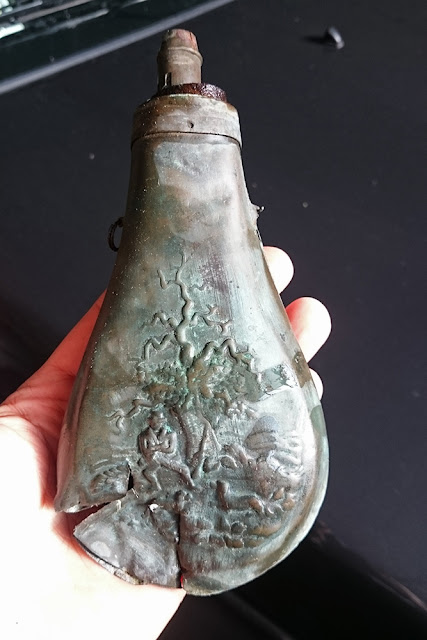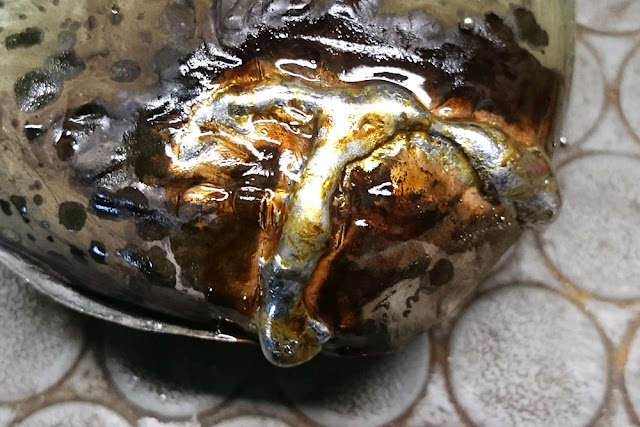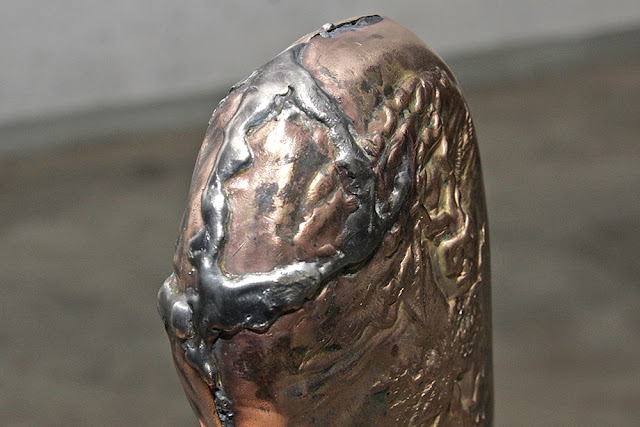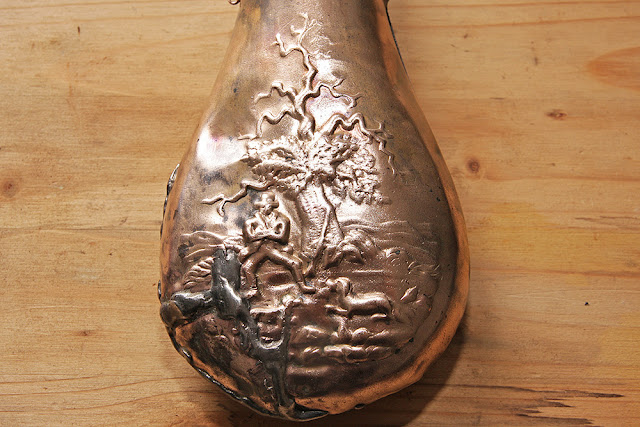Poco tempo fa mi sono finiti tra le mani i resti di una fiasca porta polvere da sparo usata un tempo per caricare le armi ad avancarica prima di ogni tiro.
Chissà per quale motivo era stata schiacciata e avevano provato a tagliarne una fetta sul fondo come si vedrà dalle foto sotto. Probabilmente volevano trasformarla in una specie di imbuto visto che anche il beccuccio era appiattito.
Prima di andare avanti vi chiederei, dato che tutto quello che faccio è per passione, se poteste gentilmente fare un click sulle pubblicità a destra. Si aprirà una pagina di sponsor, a voi non costa niente e non ci sono virus essendo tutte pubblicità di google, poi potete richiuderla. In tasca mi viene qualche centesimo e mi copre quelle poche spese di dominio e sito internet. Grazie mille davvero.
Purtroppo era davvero mal messa e quindi ho tentato un ripristino, cercando di fare una riparazione come avrebbero potuto fare all'epoca in cui era in uso la fiasca. Forse, dal punto di vista estetico, avrei avuto risultati migliori con resine composite o cose simili, ma ho deciso che avrebbe avuto più senso storico la mia scelta.
Mi sono quindi deciso ad operare una saldatura a stagno tra le parti rimaste che, una volta raddrizzate, con mia grande sorpresa combaciavano abbastanza bene.
Per ridare una curvatura accettabile alla fiasca ho lavorato dall'interno con un lungo pezzo di legno robusto con cui cercavo di fare leva sulla lamiera.
Non è stato semplice ma alla fine mi reputo soddisfatto del lavoro.
Per poter far si che la saldatura tenesse ho dovuto prima disossidare le parti con acido solforico e spazzolare bene il tutto portando a nudo il metallo.
Per questo motivo alla fine ho deciso di riportare tutta la fiasca sul metallo come doveva essere quando era nuova se no la parte saldata sarebbe stata un pugno in un occhio, il rame ossida in fretta e nel giro di qualche anno sarà di nuovo scura come quando l'ho trovata.
Veniamo ora a qualche foto delle varie fasi di lavorazione.
Ecco lo stato in cui è uscita dagli scaffali, completamente appiattita e rovinata in fondo.
Sono evidenti i segni di taglio
Per prima cosa ho smontato il tappo e ho messo le parti in ferro molto consumate a bagno in evaporust visto che non volevo rischiare di comprometterne la funzionalità. Fortunatamente la vite è venuta via bene.
Ho poi cercato di raddrizzare i pezzi tagliati e accartocciati e ho iniziato la saldatura. Non è stato facile, perchè, seppur combaciavano abbastanza, c'erano comunque delle mancanze e la lamiera vecchia tendeva a spaccarsi quando si cercava di raddrizzarla.
In prima battuta non mi sono preoccupato di quanto stagno usavo e di quanto era bella la saldatura tanto avrei grattato via il surplus in seguito.
Ed ecco le saldature finite, come si nota bene da quella di sinistra, una volta finite le ho lisciate con una lima e ripassando la fiamma sopra le ho rese meno fastidiose.
Aggiornamento del 08/04/2016.
Guardate dopo solo due mesi come si è già scurita.
Some time ago I received the remains of a flask for powder gun used to load the weapons muzzle-loading before each shot.
For some reason had been crushed and had tried to cut off a slice on the bottom as you will see from the photos below. Probably they wanted to turn it into a kind of funnel seen that the nozzle was flattened.
Before going further I would ask you, because everything I do is for passion, if you could kindly do click on ads on the right. Will open a sponsors page, you costs nothing and there are no viruses being all google advertising, then you can close it. I get a few cents in his pocket and covered my expenses and those few domain website. Thank you very much indeed.
Unfortunately it was very drafty and so I tried a restore, trying to make a repair as they could have done at the time when it was in use. Perhaps, from an aesthetic point of view, I would have had better results with composite resins or the like, but I decided I would have had more historical sense my choice.
I therefore decided to make a soldering between the remaining parties that straight, to my surprise matched pretty well.
To give a curvature acceptable to the flask I worked from the inside with a long sturdy wooden piece with which I tried to pry the sheet.
It was not easy but in the end I consider myself satisfied with the work.
In order to ensure that the weld held I had before deoxidize the parts with sulfuric acid and brush carefully.
For this reason I decided dieliminare tuttele fouling as it should be when it was new. The copper oxidizes quickly, and within a few years will be back as dark as when I found her.
We now come to some pictures of the various processing stages.
Here is the state in which it is output from the shelves completely flattened and damaged at the bottom.
First I removed the cap and put the iron parts consumed at evaporust bathroom because I did not want to risk compromising functionality. Fortunately the screw came off well.
I then try to straighten the cut pieces and crumpled, and I started welding. It was not easy, because, although matched enough, there were still shortages and the old sheet tended to split when they tried to straighten it.
At first I did not care how I used tin and how beautiful she was welding so I scraped off the surplus later.
And here's the finished welds, as can be clearly seen from the left, once finished I smoothed with a file and rehearsing the flame over I made less ugly.
Update of 08/04/2016.
Look after only two months as already darkened.
For some reason had been crushed and had tried to cut off a slice on the bottom as you will see from the photos below. Probably they wanted to turn it into a kind of funnel seen that the nozzle was flattened.
Before going further I would ask you, because everything I do is for passion, if you could kindly do click on ads on the right. Will open a sponsors page, you costs nothing and there are no viruses being all google advertising, then you can close it. I get a few cents in his pocket and covered my expenses and those few domain website. Thank you very much indeed.
Unfortunately it was very drafty and so I tried a restore, trying to make a repair as they could have done at the time when it was in use. Perhaps, from an aesthetic point of view, I would have had better results with composite resins or the like, but I decided I would have had more historical sense my choice.
I therefore decided to make a soldering between the remaining parties that straight, to my surprise matched pretty well.
To give a curvature acceptable to the flask I worked from the inside with a long sturdy wooden piece with which I tried to pry the sheet.
It was not easy but in the end I consider myself satisfied with the work.
In order to ensure that the weld held I had before deoxidize the parts with sulfuric acid and brush carefully.
For this reason I decided dieliminare tuttele fouling as it should be when it was new. The copper oxidizes quickly, and within a few years will be back as dark as when I found her.
We now come to some pictures of the various processing stages.
Here is the state in which it is output from the shelves completely flattened and damaged at the bottom.
First I removed the cap and put the iron parts consumed at evaporust bathroom because I did not want to risk compromising functionality. Fortunately the screw came off well.
I then try to straighten the cut pieces and crumpled, and I started welding. It was not easy, because, although matched enough, there were still shortages and the old sheet tended to split when they tried to straighten it.
At first I did not care how I used tin and how beautiful she was welding so I scraped off the surplus later.
And here's the finished welds, as can be clearly seen from the left, once finished I smoothed with a file and rehearsing the flame over I made less ugly.
Update of 08/04/2016.
Look after only two months as already darkened.






















complimenti
RispondiEliminaun bellissimo e funzionale recupero
Valerio
grazie a te per la visita
Elimina